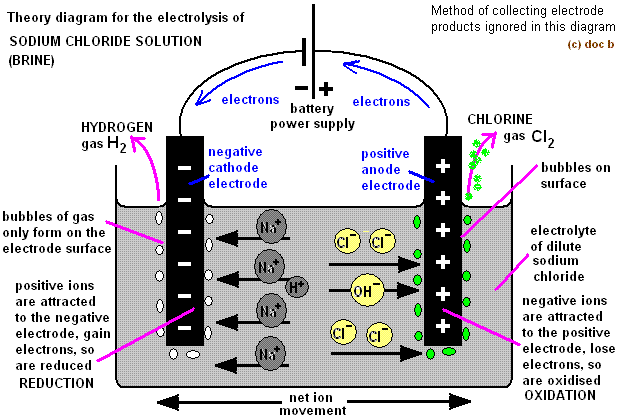Question #9a203
1 Answer
Here's what I got.
Explanation:

You know that
#2overbrace("NaCl"_ ((l)))^(color(blue)("Na"_ ((l))^(+) + "Cl"_ ((l))^(-))) -> 2"Na"_ ((s)) + "Cl"_ (2(g))# #uarr#
In this redox reaction, sodium is being reduced to sodium metal at the cathode (the negative electrode)
#"Na"_ ((l))^(+) + "e"^(-) -> "Na"_ ((s)) -># the reduction half-reaction
Chlorine is being oxidized to chlorine gas at the anode (the positive electrode)
#2"Cl"_ ((l))^(+) -> "C"_ (2(g)) + 2"e"^(-) -># the oxidation half-reaction
Now, the number of electrons lost in the oxidation half-reaction must be equal to the number of electrons gained in the redox half-reaction, which is why you have
#{(2"Na"_ ((l))^(+) + 2"e"^(-) -> 2"Na"_ ((s))), (color(white)(aaaaaa)2"Cl"_ ((l))^(+) -> "Cl"_ (2(g)) + 2"e"^(-)) :}#
So, you know that you need
Start by converting the mass of sodium metal to moles
#1.00 * 10^3 color(red)(cancel(color(black)("kg"))) * (10^3color(red)(cancel(color(black)("g"))))/(1color(red)(cancel(color(black)("kg")))) * "1 mole Na"/(22.99 color(red)(cancel(color(black)("g")))) = 4.35 * 10^4# #"moles Na"#
So, you know that you must convert
As you know, each mole of electrons is equivalent to
#4.35 * 10^4 color(red)(cancel(color(black)("moles e"^(-)))) * (9.65 * 10^4color(white)(.)"C")/(1color(red)(cancel(color(black)("mole e"^(-))))) = 4.198 * 10^9# #"C"#
Now, you know that
#"1 A" = "1 C"/"1 s"#
This means that you will need
#4.198 * 10^9 color(red)(cancel(color(black)("C"))) * overbrace("1 s"/(3.00 * 10^4color(red)(cancel(color(black)("C")))))^(color(blue)(=3.00 * 10^4"A")) = 1.399 * 10^5# #"s"#
to produce the required amount of sodium metal. Convert this to hours to get
#1.399 * 10^5 color(red)(cancel(color(black)("s"))) * "1 hr"/(3600color(red)(cancel(color(black)("s")))) = color(darkgreen)(ul(color(black)("38.9 hr")))#
Now, notice that you need
This means that the reaction will produce half as many moles of chlorine gas as you have moles of sodium metal, so
#4.35 * 10^4 color(red)(cancel(color(black)("moles Na"))) * "1 mole Cl"_2/(2color(red)(cancel(color(black)("moles Na")))) = 2.175 * 10^4# #"moles Cl"_2#
To find the volume occupied by the gas at STP, use the fact that STP conditions are usually defined as a temperature of
Using the ideal gas law equation
#PV = nRT#
Here
#P# is the pressure of the gas#V# is the volume it occupies#n# is the number of moles of gas present in the sample#R# is the universal gas constant, equal to#0.0821("atm L")/("mol K")# #T# is the absolute temperature of the gas
you will have
#V = (nRT)/P#
Plug in your values to find--do not forget to convert the temperature to Kelvin!
#V = (2.175 * 10^4 color(red)(cancel(color(black)("moles"))) * 0.0821(color(red)(cancel(color(black)("atm"))) * "L")/(color(red)(cancel(color(black)("mol"))) * color(red)(cancel(color(black)("K")))) * (0 + 273.15)color(red)(cancel(color(black)("K"))))/(1color(red)(cancel(color(black)("atm"))))#
#color(darkgreen)(ul(color(black)(V = 4.88 * 10^5color(white)(.)"L")))#
The answers are rounded to three sig figs, the number of sig figs you have for your values.

